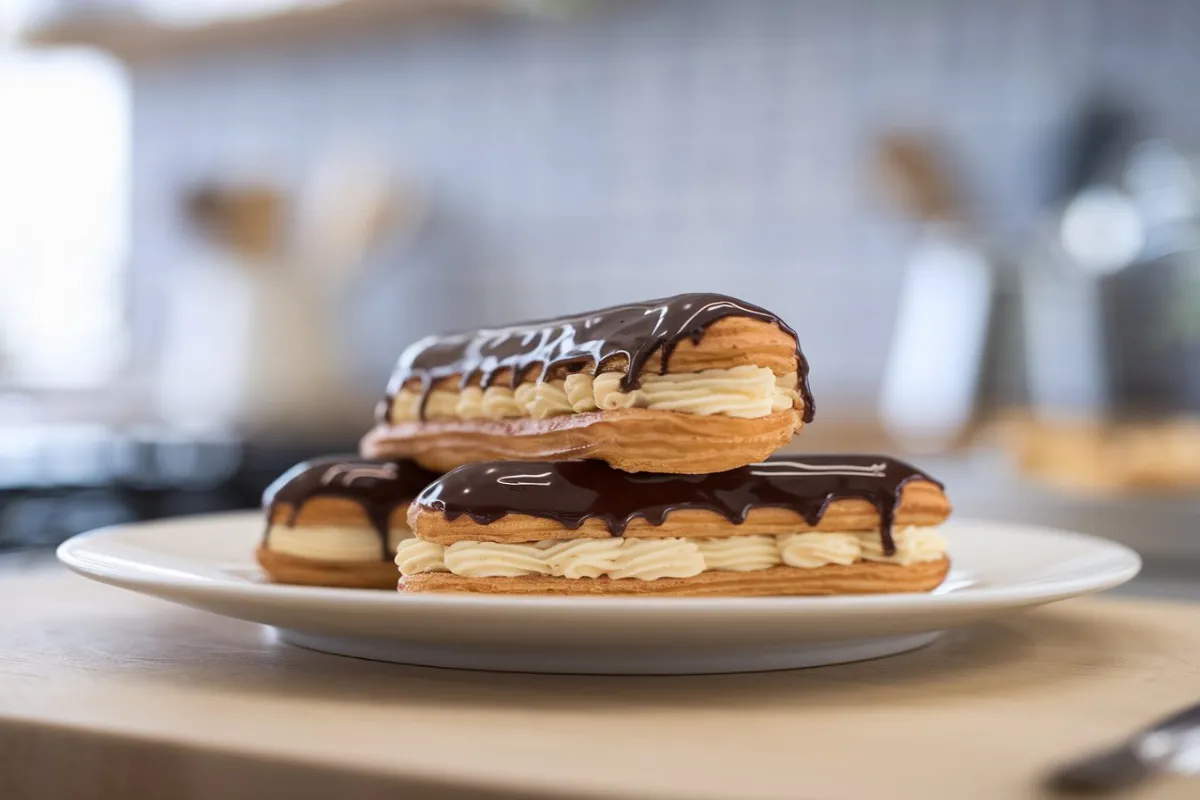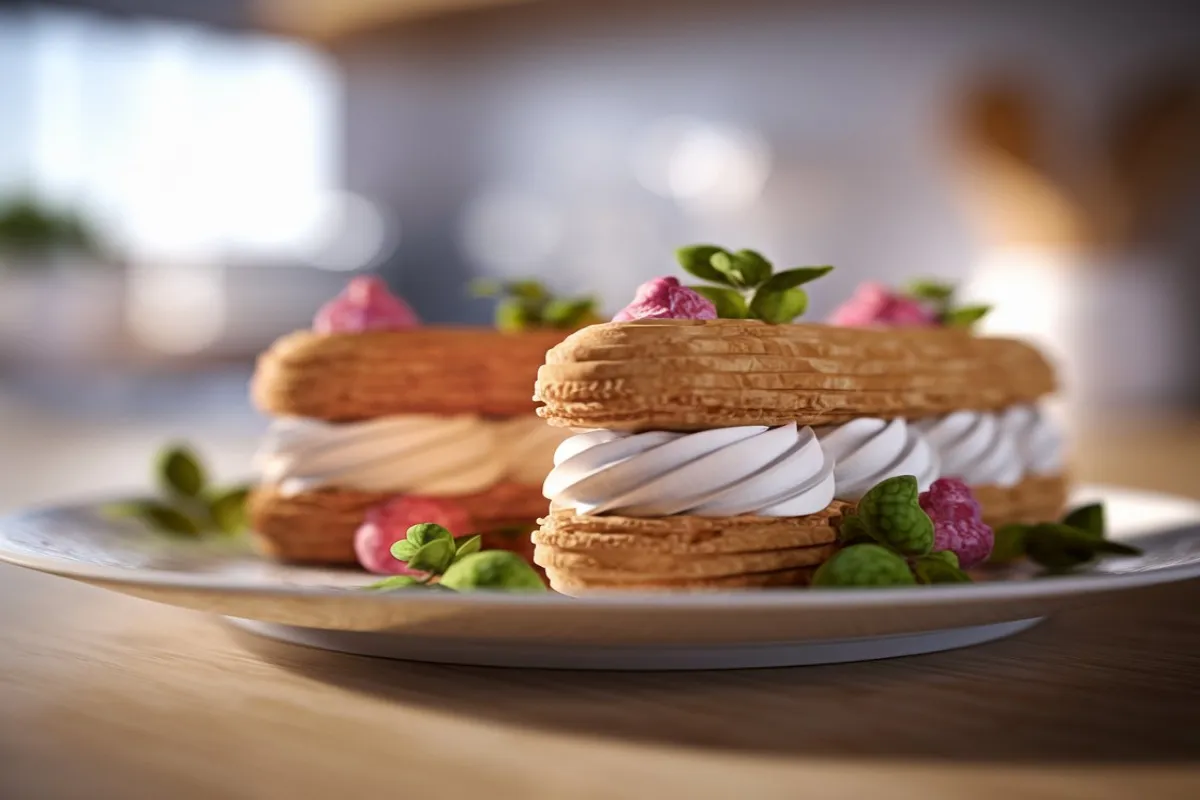Éclairs are a classic French pastry, adored worldwide for their delicate balance of crispy choux pastry and rich, creamy filling. However, what exactly goes into making this luxurious filling? This article delves deep into the world of éclair fillings, exploring traditional recipes, modern variations, and expert techniques to ensure you can create the perfect éclair at home.
Introduction to Éclair Filling
The French word for “flash of lightning,” Éclairs, derives their name from their quick consumption. These delectable pastries are famous for their delightful filling, which is key to their irresistible flavor and texture. Understanding what goes into an éclair filling is crucial for both amateur and professional bakers who want to master this classic treat.
Why the Filling Matters
The filling is the heart of the éclair. It provides the creamy contrast to the crisp pastry shell, making each bite a harmonious blend of textures and flavors. Whether you opt for a traditional vanilla pastry cream or a more modern chocolate or fruit-based filling, getting the filling right is essential for an authentic éclair experience.
Historical Background
The éclair’s history dates back to the early 19th century, with its origins rooted in French culinary tradition. The original éclair filling was a simple yet luxurious pastry cream made from a few basic ingredients. Over time, bakers began experimenting with different flavors and techniques, leading to the variety of fillings we enjoy today.
Traditional Éclair Filling Ingredients
The Basics: Pastry Cream
At the core of any classic éclair is pastry cream, a rich, custard-like filling that is smooth, creamy, and perfectly sweetened. Milk, sugar, eggs, and a thickening agent like flour or cornstarch combine to make pastry cream. The secret to a perfect pastry cream lies in balancing these ingredients to achieve the right consistency and flavor.
- Milk: As the foundation of pastry cream, milk provides the necessary liquid and richness.
- Eggs, or more specifically, egg yolks, are critical for creating a thick, creamy texture.
- Sugar: The filling’s sweetness comes from sugar, which also helps to stabilize the custard.
- Thickening Agents: To give the cream the proper consistency for filling éclairs, thicken it with flour or cornstarch.
- Vanilla: Pastry cream often incorporates vanilla extract or vanilla beans for a classic, aromatic flavor.
Eggs are the binding agent.
Eggs are the unsung heroes of éclair filling. They not only thicken the cream but also add a rich, custard-like texture that makes the filling so indulgent. You can use whole eggs, but many recipes call for just the yolks to ensure a richer and creamier filling. The choice between using whole eggs or just yolks depends on the desired consistency and richness.
Dairy Products
The choice of dairy has a significant impact on the texture and flavor of the éclair filling. Traditional bakers use whole milk, but some opt for a blend of milk and cream to enhance the richness. This combination not only enhances the flavor but also contributes to a smoother, more luxurious filling.
- Whole Milk: Provides a balanced creaminess without being too heavy.
- Cream adds a rich, velvety texture to the filling, making it more decadent.
Sweeteners: Sugar and Alternatives
Sugar is a key ingredient in éclair filling, providing the necessary sweetness to balance the richness of the eggs and dairy. However, modern recipes often explore alternative sweeteners like honey or agave syrup, which can add a unique flavor profile while reducing refined sugar content.
- Sugar: The traditional sweetener, essential for balancing the flavors.
- You can use honey or agave as alternative sweeteners to change the flavor and sweetness level.
Thickening Agents: Flour vs. Cornstarch
The choice of thickening agent can greatly affect the texture of the filling. While flour is more traditional, people often prefer cornstarch for its ability to create a smoother and lighter cream.
- Flour adds a subtle taste and thickens the cream to a more custard-like consistency.
- Cornstarch provides a lighter, smoother texture, ideal for a delicate filling.
Modern Variations in Éclair Fillings
As the culinary world evolves, so do the flavors and styles of éclair fillings. Modern pastry chefs have taken the traditional pastry cream and added their own twists, resulting in a wide range of innovative fillings.
Chocolate éclair filling
Chocolate is one of the most popular variations for éclair fillings. By incorporating melted chocolate or cocoa powder into the pastry cream, you can create a rich, decadent filling that pairs perfectly with the crispy choux pastry.
- Dark chocolate adds a deep, intense flavor and pairs well with the sweetness of the pastry.
- Milk Chocolate: A milder option that provides a creamy, sweet contrast to the pastry.
For those looking to create a chocolate éclair filling, it’s crucial to balance the richness of the chocolate with the sweetness and consistency of the pastry cream. You can explore the best custard recipe for éclairs to find tips on perfecting the chocolate variant.
Fruit-Based Fillings
Fruit-based fillings offer a refreshing alternative to the traditional pastry cream. You can puree and incorporate popular fruits like strawberries, raspberries, and passion fruit into the cream, adding a tangy sweetness that complements the richness of the éclair.
- Strawberries: Provide a sweet, tangy flavor that pairs well with vanilla pastry cream.
- Raspberries: Add a vibrant color and tartness, ideal for summer éclairs.
- Passion Fruit: offers an exotic flavor with a perfect balance of sweet and sour.
Making fruit-based fillings requires a delicate balance of sweetness and acidity, ensuring that the fruit enhances rather than overpowers the cream.
Custard vs. cream-based fillings
While custard-based fillings are traditional, some modern recipes prefer lighter, cream-based fillings, such as chantilly cream or whipped cream. These alternatives offer a distinct texture and allow for a variety of flavor combinations.
- Custard-Based Fillings: Rich, thick, and indulgent, ideal for a classic éclair experience.
- Cream-Based Fillings: Light, airy, and perfect for those who prefer a less dense filling.
When deciding between custard and cream-based fillings, consider the overall texture and flavor profile you wish to achieve. Custard is richer and more traditional, while cream-based fillings are lighter and more versatile.
Innovative Flavors
The world of éclair fillings has expanded far beyond the traditional vanilla and chocolate. Modern bakers are experimenting with flavors like matcha, coffee, and caramel, offering a wide range of exciting and innovative options.
- Matcha: Adds a subtle bitterness and vibrant green color, perfect for pairing with white chocolate.
- Coffee offers a rich, aromatic flavor that is perfect for pairing with chocolate or caramel.
- Caramel adds a sweet, buttery richness, creating a luxurious filling.
Exploring these innovative flavors can lead to a more personalized and unique éclair experience. For those interested in trying out new flavor combinations, check out this guide on exploring modern éclair flavors.
Preparation Techniques for Éclair Fillings
Making the perfect éclair filling requires both technique and ingredients. Understanding the proper methods for cooking, flavoring, and storing your filling is crucial for achieving the best results.
Cooking the Pastry Cream
The process of cooking pastry cream involves gently heating the milk, sugar, and eggs until the mixture thickens. This step requires constant stirring and careful temperature control to prevent curdling.
- Step-by-Step Guide:
- Heat the milk and half the sugar in a saucepan until just boiling.
- In a separate bowl, whisk the egg yolks with the remaining sugar and thickening agent.
- Slowly pour the hot milk into the egg mixture, whisking continuously to prevent the eggs from scrambling.
- Return the mixture to the saucepan and cook over medium heat, stirring constantly until it thickens.
- Once thickened, remove from heat and add vanilla extract or other flavorings.
- Strain the pastry cream into a clean bowl to remove any lumps.
- Cover the surface with plastic wrap to prevent skin from forming, and allow it to cool.
This method ensures a smooth, creamy pastry cream that is perfect for filling éclairs.
Incorporating Flavorings
Adding flavorings to your éclair filling can elevate it from simple to extraordinary. Whether you prefer classic vanilla or something more adventurous like matcha, it’s essential to incorporate these flavors at the right stage of cooking.
- When to Add Flavorings:
- After the pastry cream has thickened but is still warm, add vanilla extract or vanilla beans to allow the flavors to infuse.
- Once the pastry cream has cooled slightly, incorporate chocolate or fruit purées to prevent curdling.
- For more delicate flavors like matcha or coffee, whisk them into the cooled pastry cream to preserve their unique characteristics.
Experimenting with different flavor combinations can lead to delightful results, making your éclairs truly one-of-a-kind.
Cooling and Storing
Proper cooling and storage of éclair filling are essential for maintaining its texture and flavor. Once cooked, quickly cool the pastry cream and store it in an airtight container to prevent bacterial growth and maintain its freshness.
- Cooling Techniques:
- To quickly cool the bowl of pastry cream, place it over an ice bath.
- Stir occasionally to release steam and prevent a skin from forming.
- Storage Tips:
- Store pastry cream in the refrigerator for up to three days.
- Cover the surface with plastic wrap to prevent it from absorbing other flavors in the fridge.
These methods guarantee the freshness and deliciousness of your éclair filling, ready for piping into your choux pastry.
FAQs: Frequently Asked Questions
What is the difference between pastry cream and custard?
Pastry cream is a type of custard thickened with flour or cornstarch, making it more stable for filling pastries like éclairs. Custard, on the other hand, is a broader term that can refer to any mixture of milk or cream and eggs thickened by gentle heating. While all pastry creams are custards, not all of them are pastry cream.
Can I make an éclair filling without dairy?
Yes, it’s possible to make a dairy-free éclair filling by substituting the milk and cream with plant-based alternatives like almond milk, coconut milk, or soy milk. You can find more tips on making a dairy-free pastry cream that still provides the richness and creaminess required for a delicious éclair filling.
What are the common mistakes when making éclair filling?
Some common mistakes include not cooking the pastry cream long enough, resulting in a runny filling, or cooking it too long, leading to curdling. Another mistake is not cooling the filling properly, which can cause it to develop an unpleasant skin or lose its smooth texture.
How can I thicken my éclair filling if it’s too runny?
If your éclair filling is too runny, you can return it to the heat and continue cooking while stirring constantly. Alternatively, you can whisk in a slurry of cornstarch and water, then cook until the filling thickens to the desired consistency.
Conclusion
Creating the perfect éclair filling is a balance of using high-quality ingredients, mastering the correct techniques, and adding your personal touch with flavors and variations. Whether you stick to the traditional pastry cream or experiment with modern twists like chocolate or fruit-based fillings, the key is to enjoy the process and savor the delicious results.
By following this comprehensive guide, you’ll be well on your way to making éclairs that are not only visually stunning, but also a delight to eat. Remember, the filling makes the éclair, so adjust it carefully.
For further reading on dessert-making techniques, check out this ultimate guide to biscoff cheesecake, which offers insights that could inspire your next baking adventure.

